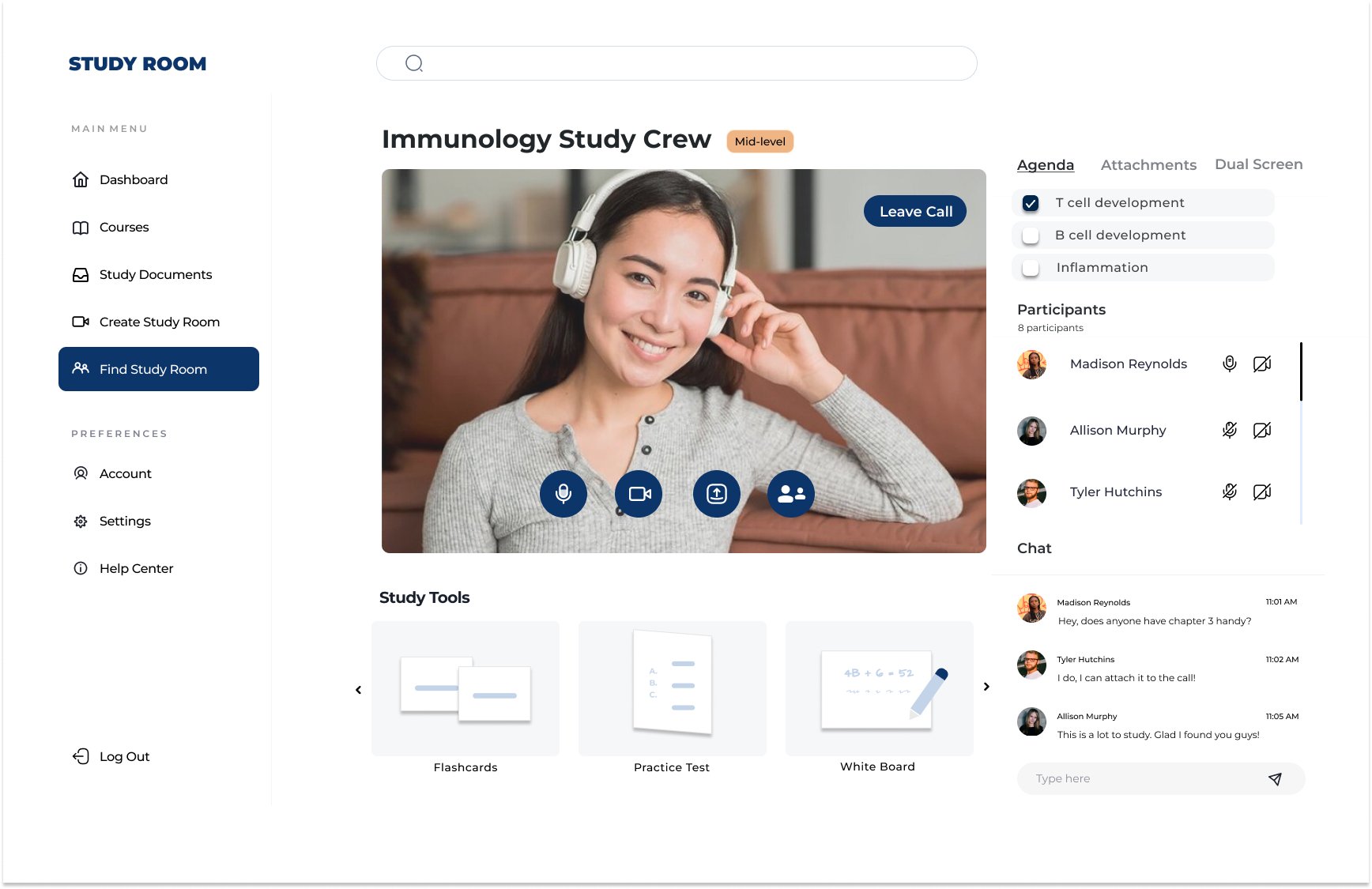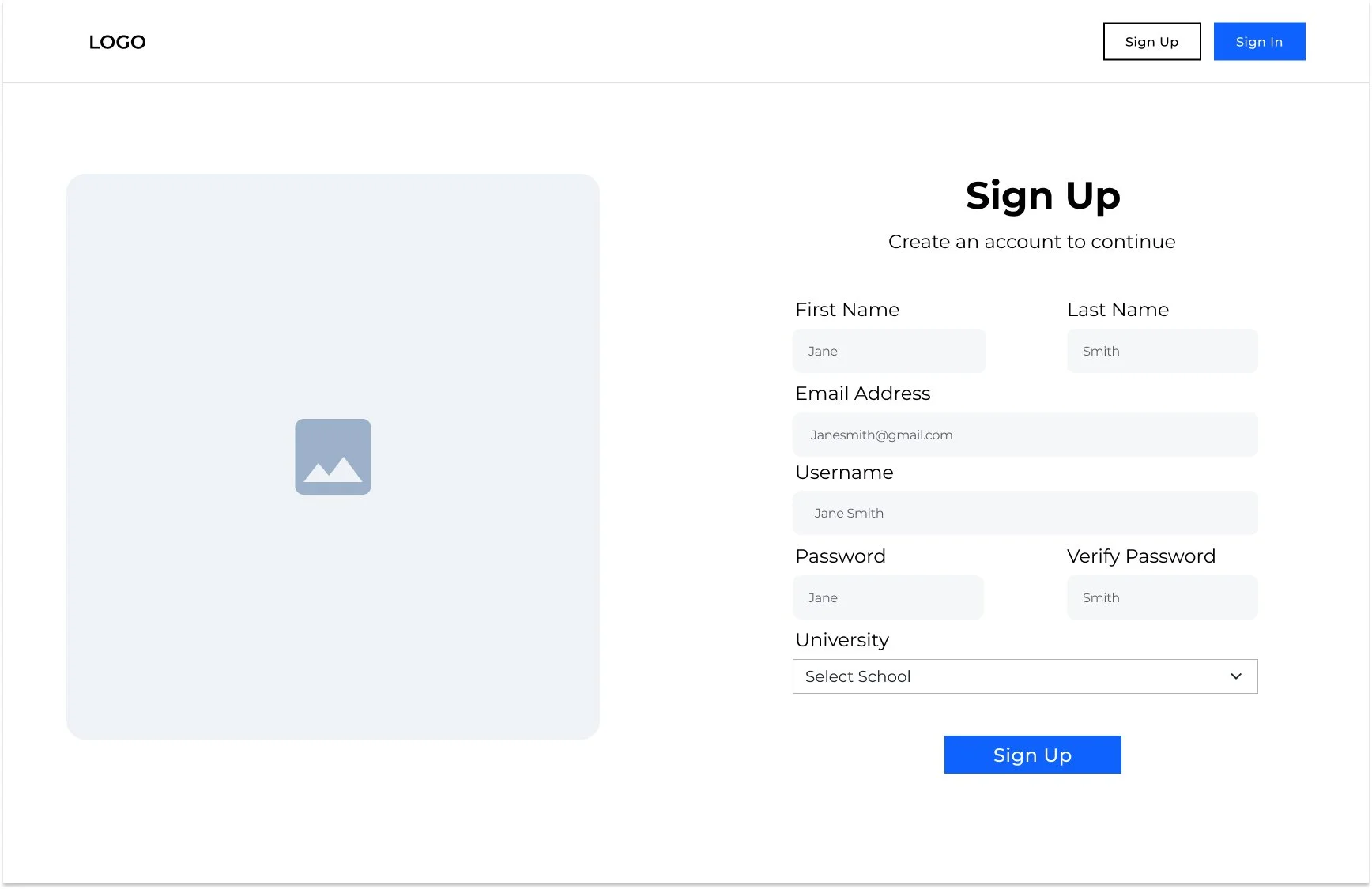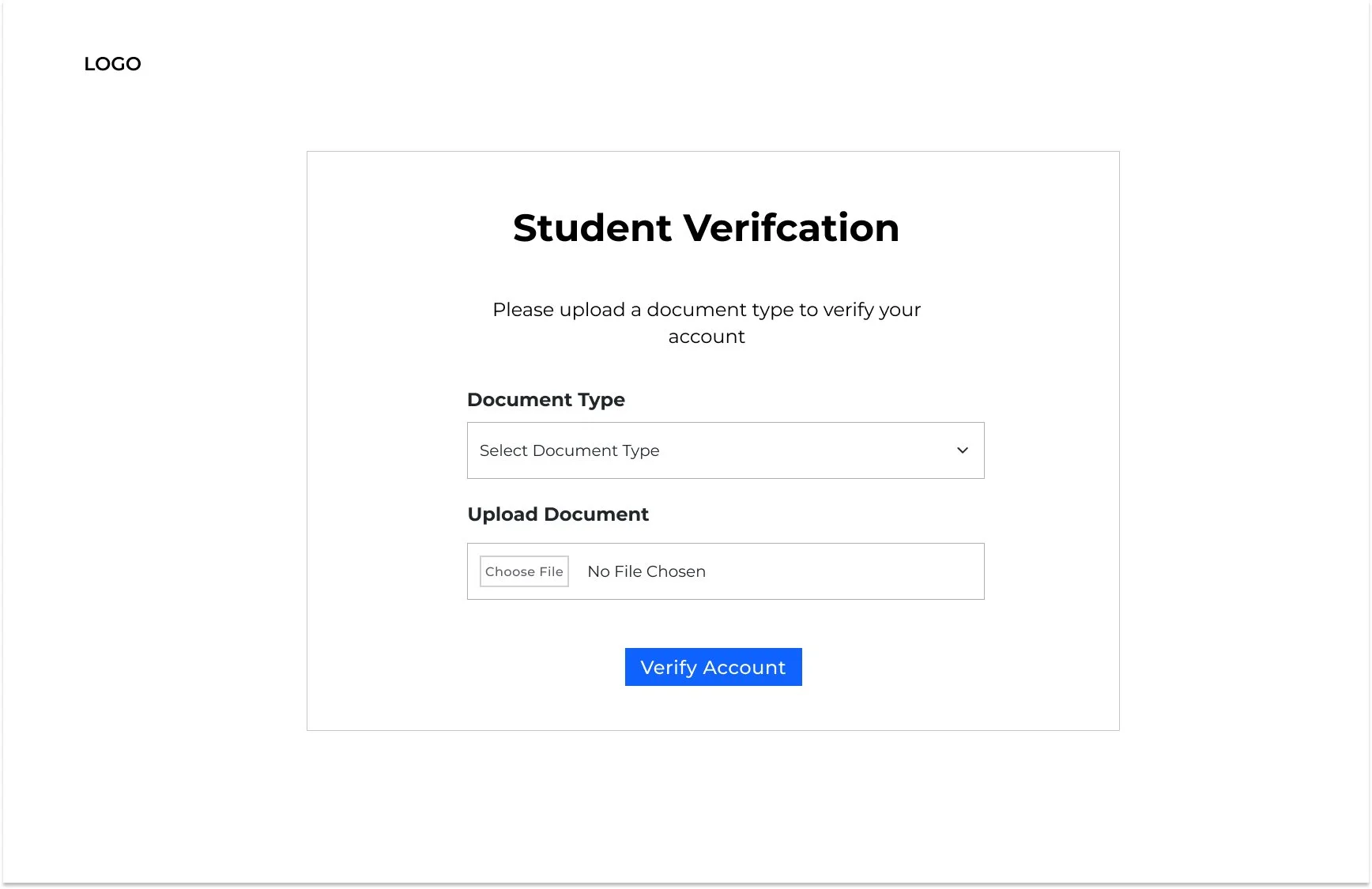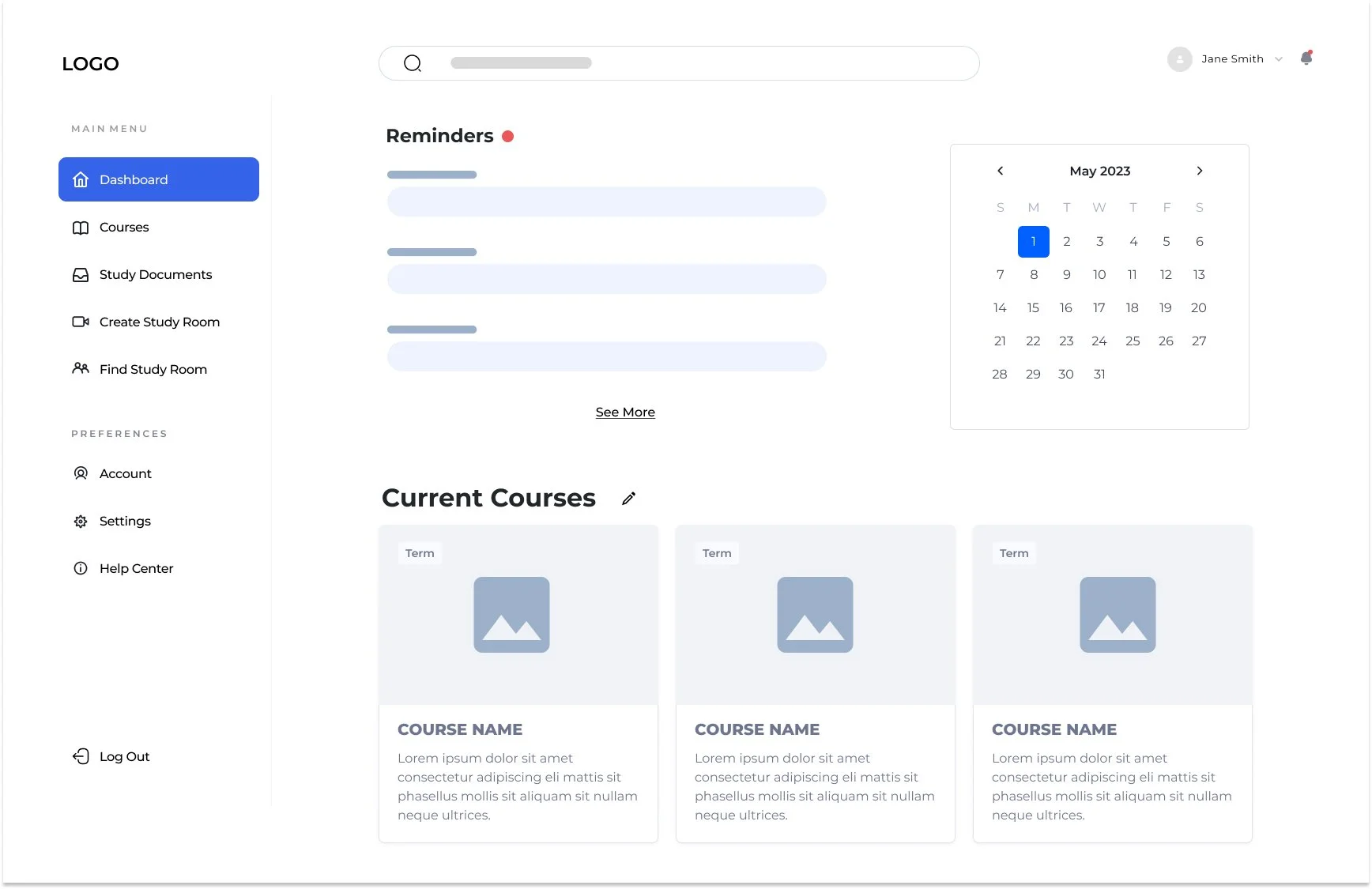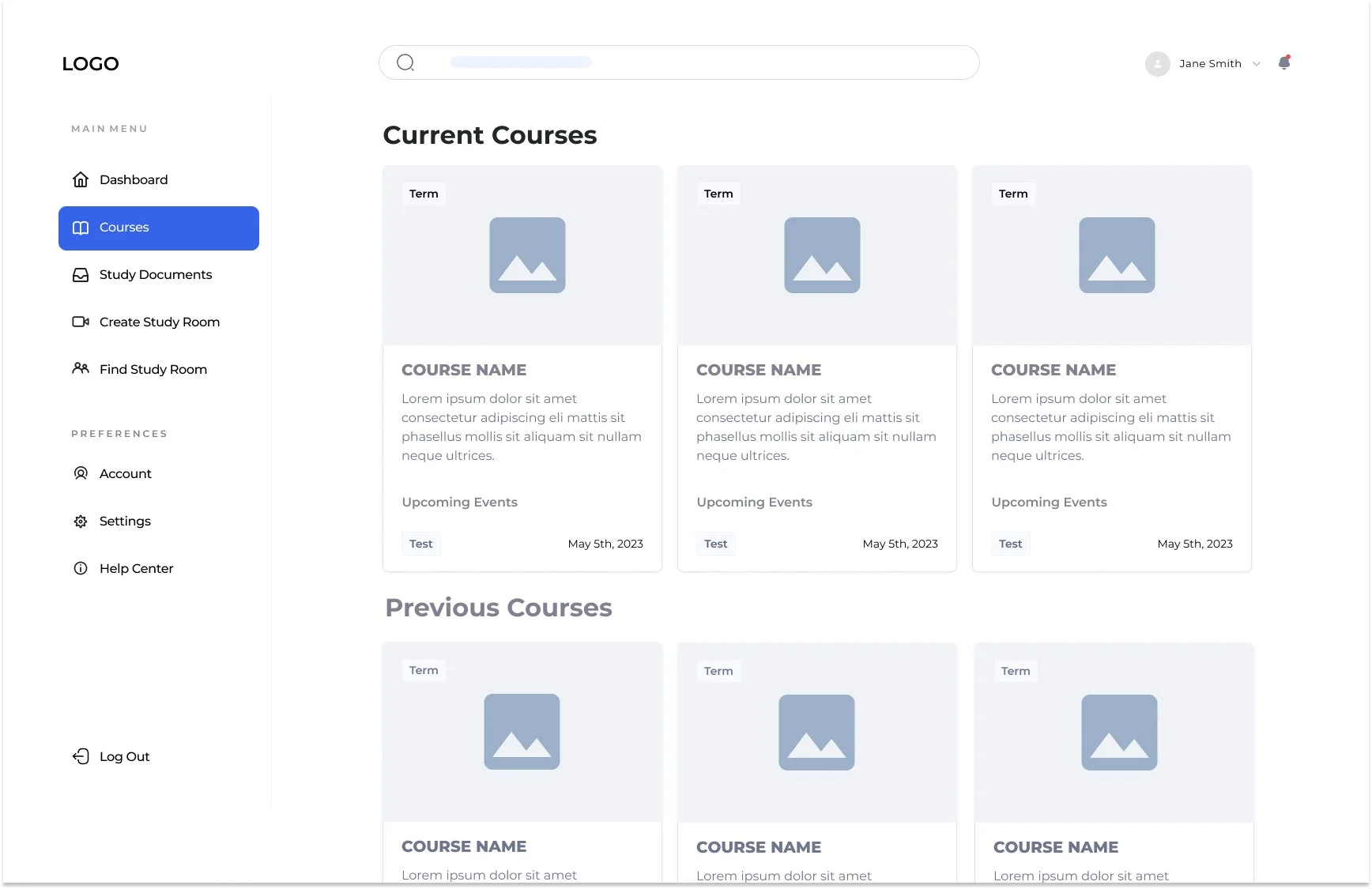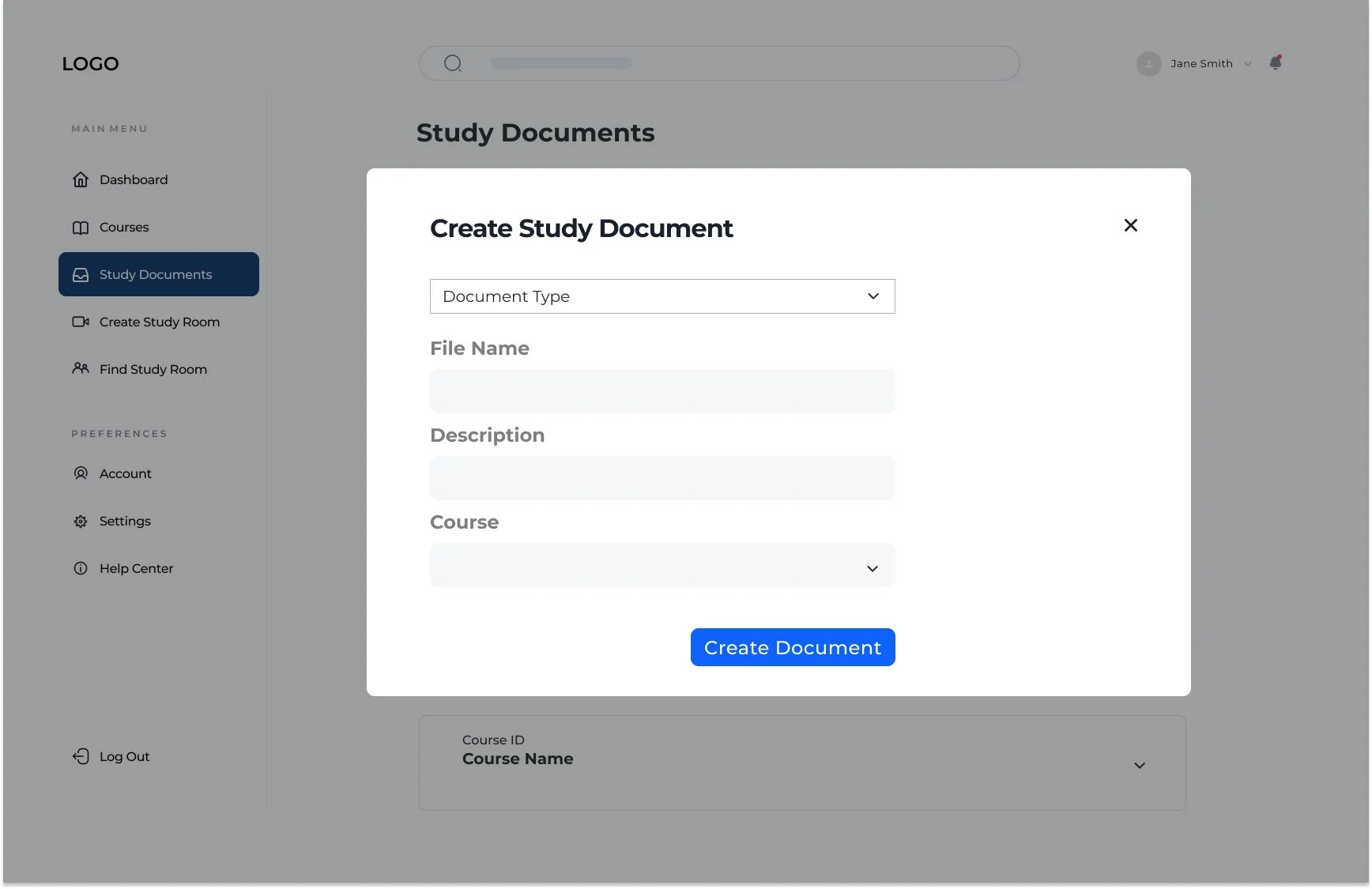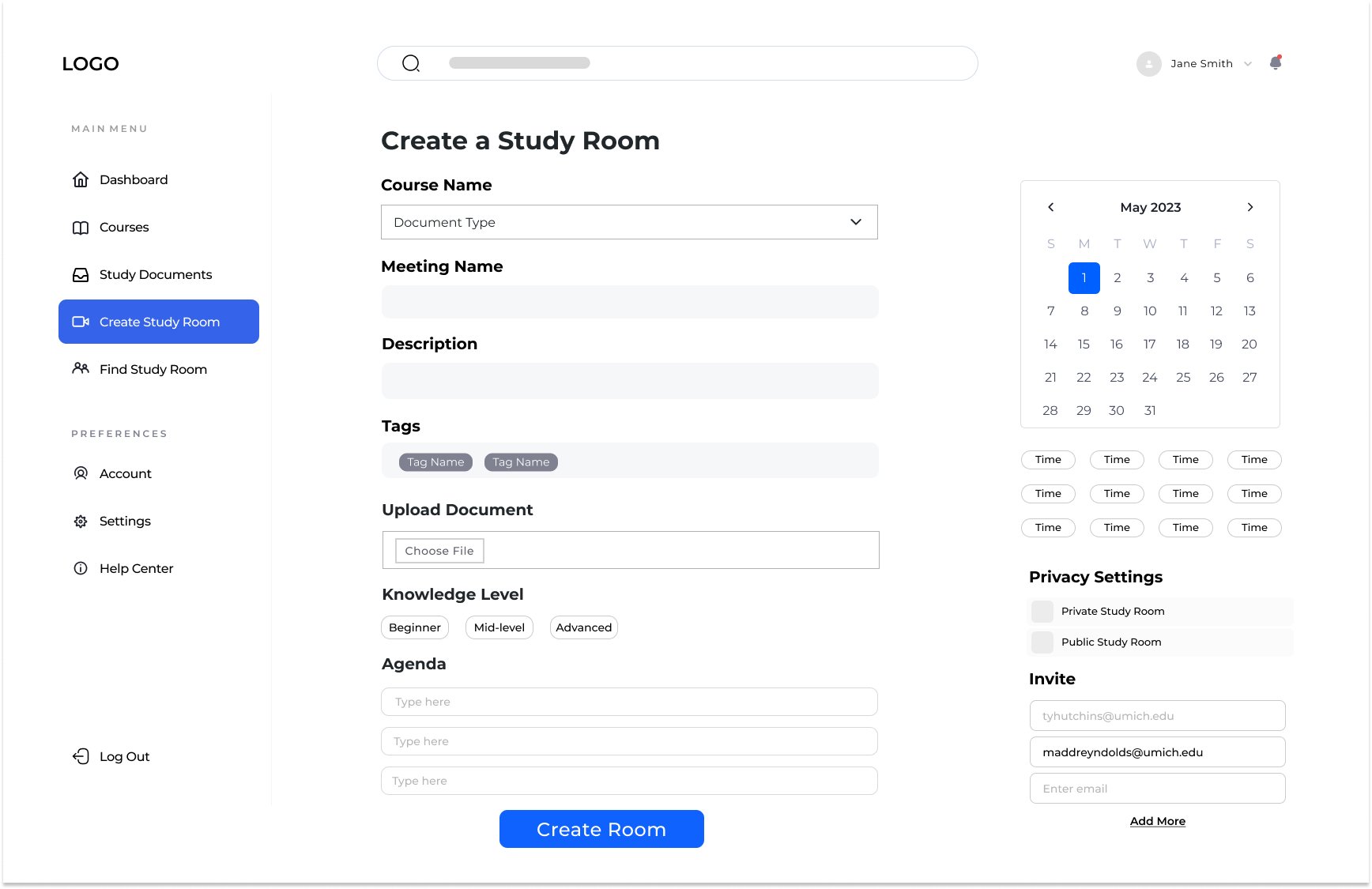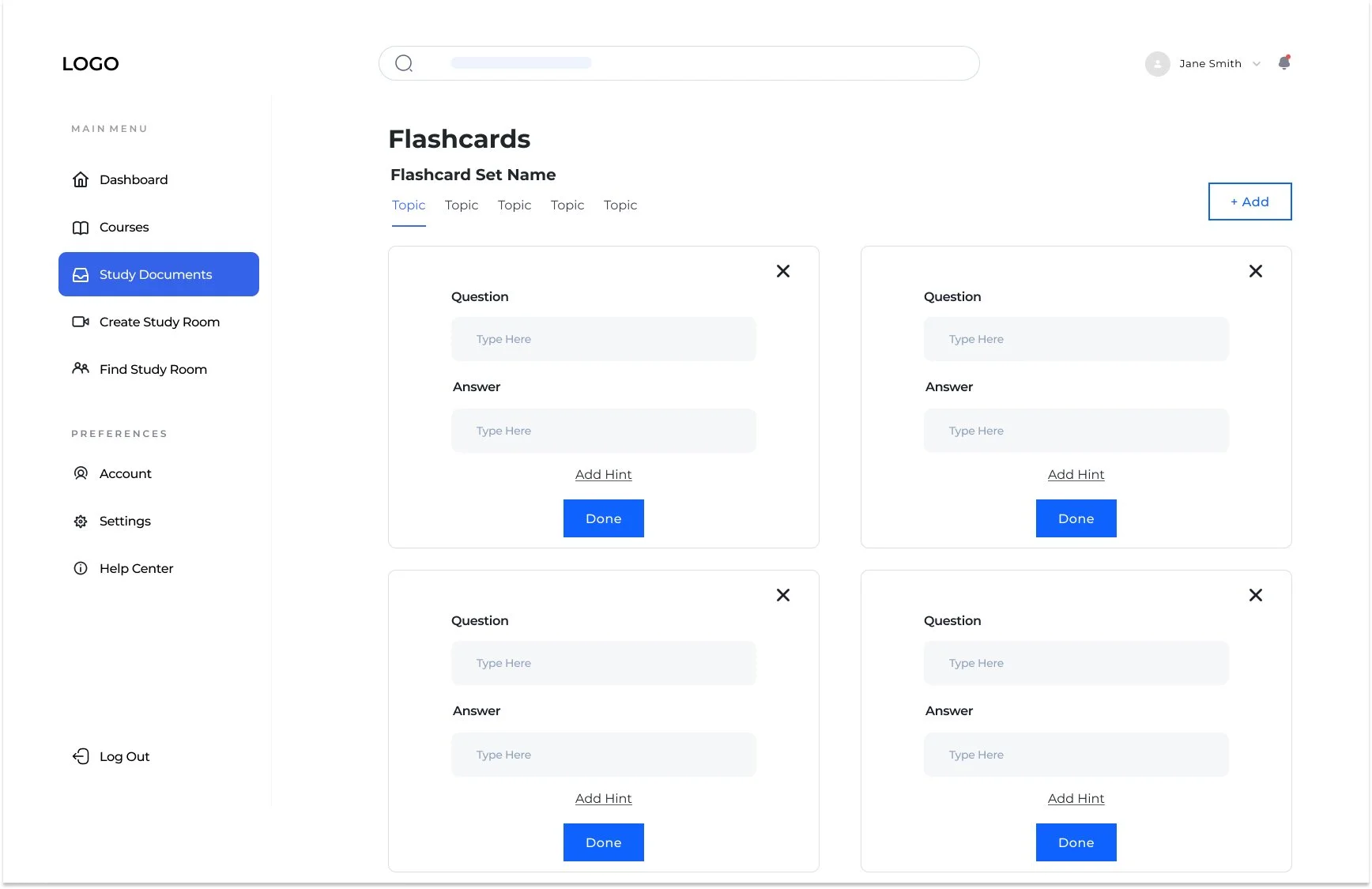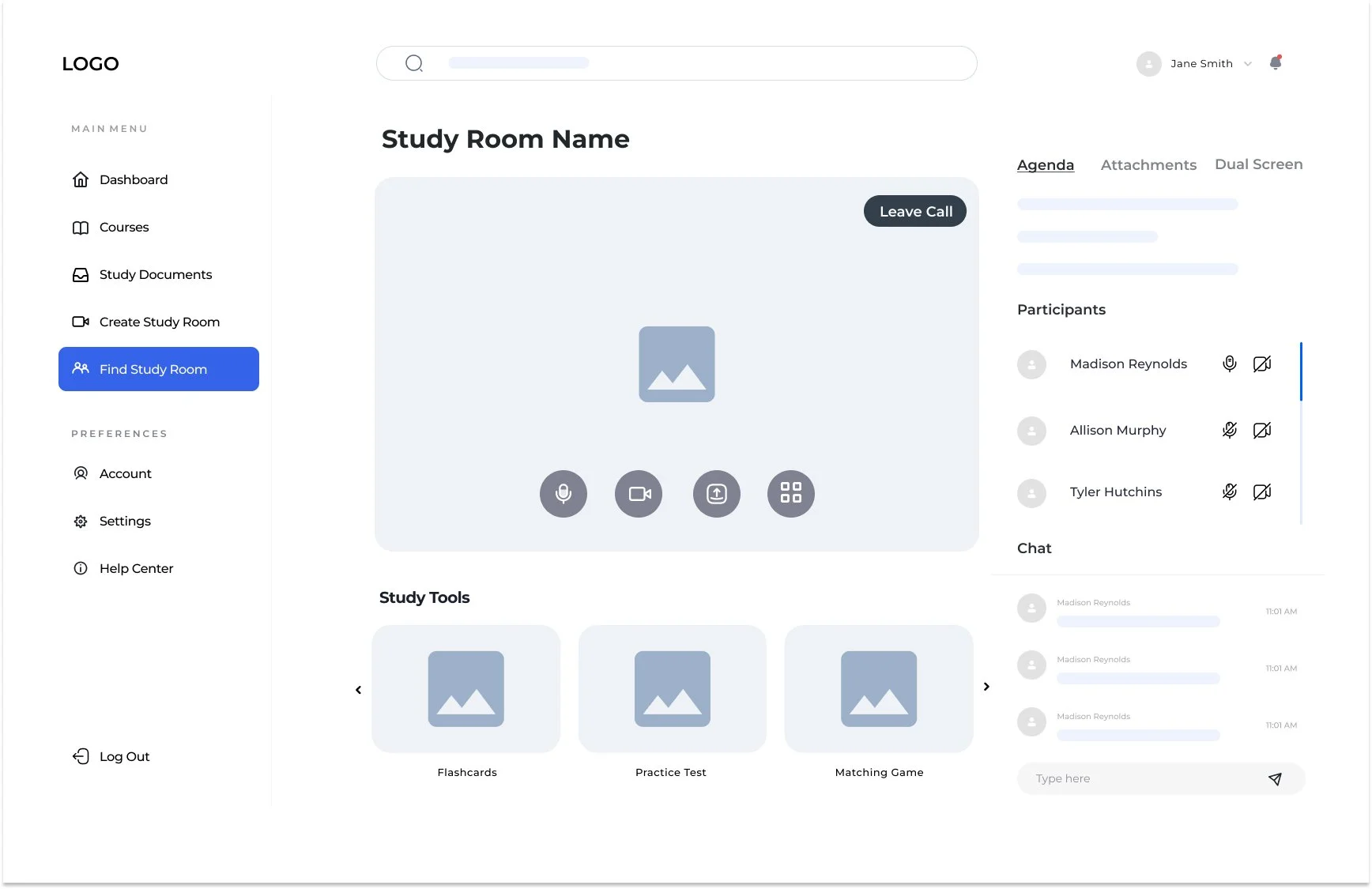Study Room
Despite the recognized success of collaborative study experiences, students often struggle to form study groups within their classes. Study Room aims to help students by providing a platform that enables collaborative learning through live study sessions, collaborative study materials, and game-based learning activities.
“Transform your study routine into a shared experience where success is defined by collaboration”
Role
UX Researcher & Designer
Timeline
September - December 2023
Tools
Figma
Photoshop
The Problem.
Throughout the semester, students expressed challenges with finding a community of scholars to study with, especially when studying These difficulties stemmed from conflicting schedules, unfamiliarity with classmates, and ineffective communication channels. As a result, students frequently found themselves studying alone and having to prepare for academic testing independently.
The Solution.
Study Room is a college-based platform designed to assist students in finding study groups, connecting with classmates, and improving their understanding of course material through collaborative learning.
The platform enables students to easily join or create study group sessions and share content such as study guides and flashcards. Users can efficiently sort for study group sessions based on their institution and course name. The study sessions, coupled with built-in learning activities, contribute to enhancing students' comprehension of course material through collaborative learning.
Dashboard View
-
Students can add courses to the platform and leverage them to discover a virtual community of resources, templates, study guides, and scheduled study sessions.
-
Students can add important events to their calendar and will receive reminders on their dashboard.
Study Documents
-
Students can store documents within their respective courses, and the option to add tags to each document ensures easy retrieval for efficient organization and accessibility.
-
Students can create a diverse array of study materials, comprising flashcards, practice tests, presentations, and study games, which can be uploaded to the community, shared with classmates, and attached to study session meetings.
Study Room
-
Students can attach documents to the study room meeting for classmates to view and utilize built-in study tools such as flashcards, practice tests, and even a whiteboard. The meeting also enables students to set and check off a study agenda as they progress.
-
Students can filter by a wide range of categories such as course name, session date, and knowledge level to find the right group of peers to study with.
Design Process.
1. Research
Utilized surveys to gain a deeper understanding of students study needs and habits.
2. Analysis
Constructed a journey map based on survey findings, and conducted competitive analysis to identify areas of opportunity.
3. Brainstorming
Brainstormed and prioritized possible solutions. Built a sitemap to determine the arrangement of pages and information.
4. Wireframing
Created wireframes to outline key elements and the flow of the application.
5. A/B Testing
Conducted usability testing to evaluate designs and test out user reactions to different versions of the same page.
6. Design Handoffs
Prepared high-fidelity mockups, user flows, and design specification hand-offs for a hypothetical development team.
Survey.
Developed a survey with 10 questions, focused on gathering valuable insights into students study habits and preferences regarding collaborative learning.
Based on insights provided by 24 students, here are our key findings:
75% of students prefer to study in groups
While the majority of students indicated that they frequently study alone, 75% expressed a preference for group study sessions.
Majority of students use their laptops to study
When asked about their preferred study devices, the majority of students chose a laptop. Tablets were the second most utilized device.
87.5% of students use Quizlet as their primary study platform
The majority of students using Quizlet, also aligns with the survey results indicating that flashcards are a preferred study method.
Sample Questions
-
Do you prefer studying alone or in a group?
How often do you engage in group study sessions?
How do you currently find study partners or groups?
What challenges do you face when trying to find or join study groups?
-
How do you typically prepare for exams or assessments?
What technology or tools do you commonly use for studying?
-
What platforms do you currently use for studying?
What features would you find most valuable in a collaborative learning platform?
Journey Map.
Crafted a journey map to visually represent students' studying experiences to deepen empathy and understanding of their needs, frustrations, and motivations. The map served as a valuable tool to pinpoint specific areas where users might be encountering frustration or dissatisfaction, enabling us to prioritize and uncover opportunities for improvement within the platform.
Competitive Analysis.
Results from the survey revealed that Quizlet and Chegg as the most popular study platforms. To gain more insights into competitors and pinpoint advantages for the Study Room, we conducted research on the key features offered by leading platforms.
KEY TAKEAWAYS:
1. While all competitors allow flashcard creation, there is a lack of game-based learning options.
2. While competitors allow users to search content, there are no platforms that allow you to search for study groups based on courses and knowledge levels.
3. Platforms that have video conferencing rely on extensions and third parties for flashcards or learning games.
4. There are dedicated group studying websites like StudyVerse and Study Together however, these platforms emphasize individual studying in a shared environment instead of collaborative studying.
Brainstorming.
Conducted a 30-minute brainstorming session to generate potential solutions based on identified problems. Following the brainstorming session, I crafted a prioritization matrix to assess the significance and feasibility of each solution, aiding in the decision-making process for designs.
Sketches.
Mid - Fidelity Wireframes.
Usability and A/B Testing.
The usability test focused on understanding initial reactions to the following screens: Dashboard, Study Documents, Create Study Rooms, and Study Rooms
Testing was conducted with 12 students ranging from various academic levels and programs:
5 Undergraduate Students
6 Master Student
1 Phd Student
To determine which versions of the Study Document and Study Rooms screens helped users find content easily, half of the users were given version A and the other half version B.
Study Document Version A
Users quickly understood the layout of the page
Users spent less time scanning the content on this page
Users liked grouping documents by course
Study Document Version B
Users spent more time browsing through content on this page
Users spent more time on filters than other content on this page
Users focused on the date and description of documents
Study Rooms Version A
Users explored the study tools within seconds
Users easily found content on the page within seconds of looking for it
Users comments on study tools focused more on the images
Study Rooms Version B
Users spent more time identifying all of the features available
Users ignored the participant view at the bottom of the page
Users ignored section headers (agenda, etc.) and spent more time understanding study tools
Final Design.
Take a look into the final screen designs for Study Room




